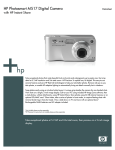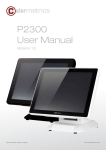Download User Manual - Live Life Alarms
Transcript
User Manual The LiveLife Personal Medical Alarm POWER ON 1 2 3 4 5 6 7 8 9 0 # * HELP 1 Overview 3 Installation Guide 6 Operating instructions 8 Troubleshooting 9 Specifications 10 Warranty LiveLife PERSONAL MEDICAL ALARMS www.livelifealarms.com.au ©2015. LiveLife Alarms. All rights reserved. 1 Overview Live a full Life. message that had been recorded previously. The receiver can now assist by arranging for someone to attend the user’s home. The LiveLife Alarm is a simple to use medical alert system. The user wears a pendant with a HELP button. In an emergency they press the HELP button and the alarm system automatically calls up to 3 nominated family and friends that can assist. The alarm unit will dial them in order until a real person answers and acknowledges the ‘help’ ‘help’ call. It can call landlines and mobiles. If the first person on the list does not answer, the alarm will then call the second person and then the third person. It will try calling each person up to five times in a cycle if necessary. Once one of these 3 people answer the call and BEFORE YOU START then acknowledge by pressing a key on their *This alarm can form part of your phone, the alarm then plays the short ‘help’ advance emergency plan. Included in package Before you install and operate the alarm you should contact the 3 people who would receive a help call in the eventuality you need help. 1 x Main alarm unit 2 x Pendants with necklace 1 x Power adaptor 1 x Phone line splitter 1 x Alarm to phone line cable 1 x User manual We have included 3 ‘Receiver cards’ you can share with these people which contain some instructions on how the alarm works. The alarm should be tested before it is used, so you will need to inform them prior to you testing the alarm. * Please read the medical disclaimer on page 11. 1 x Receiver card ©2015. LiveLife Alarms. All rights reserved. 2 Overview Front of alarm unit with lid open Microphone Power on indicator POWER ON Low battery indicator Speaker Standby indicator On-Off switch Store phone number buttons Handset button 1 2 3 4 5 6 7 8 9 0 # * Wireless antenna Play recorded message Record message button Help button HELP Rear of alarm unit with cover open Underneath of alarm unit Back-up battery compartment AAA Power socket Alarm to phone line cable Phone line socket Power adaptor AAA Phone line splitter Pendants & necklaces Help button ©2015. LiveLife Alarms. All rights reserved. 3 Installation Connections Unpack your alarm from the box and locate all items (Refer to the list on page 1 of this manual). Please note this alarm requires a standard landline service to be active in your home. Standard installation If you use a computer connected to the internet that uses an ADSL connection please refer to ‘Diagram B’ (page 5). The diagram below refers to a home using a landline without ADSL internet. Existing Phone Powerpoint Power adaptor Rear of alarm unit CABLE B Supplied splitter Wall phone socket CABLE A (supplied) DIAGRAM A A Connect power 1 Choose a location for the alarm unit near your phone wall socket. 2 Plug the power adaptor into a power point nearby. 3 Lift the cover at the rear of the alarm unit. 4 Plug the black power adaptor cable into the rear socket. TIP It is a good idea to protect the alarm from power surges by plugging it’s power in B Connect alarm to your phone line 1 Remove the cable (B) to your phone from your wall phone socket. 2 Plug the supplied phone splitter directly into your wall phone socket. 3 Plug the cable (B) to your phone into one of the sockets in the splitter. 4 Plug the cable (A) to the alarm unit into the remaining socket in the splitter. 5 Now plug the other end of the cable (A) into the rear of the alarm unit. to a powerpoint that is surge protected. ©2015. LiveLife Alarms. All rights reserved. 4 Installation C Turn on alarm POWER ON 1 Flip open the alarm unit’s cover. POWER ON 2 Turn the alarm on at the unit’s side switch. ON OFF 3 The green power light will come on and stay on. 1 2 3 4 5 6 7 8 9 0 # * POWER ON 4 The red standby light will flash for 3 seconds during HELP start-up and then go out. The unit will then beep once to indicate it is ready. TIP After you install and program your alarm please install 4 x AAA alkaline back-up batteries. Programming Now that you have completed setting up the connections to your alarm the next steps are to program in up to 3 phone numbers on your contact list and record a ‘help message’. D Program up to 3 numbers 1 phone number just repeat the process. Do not use 000 as one of your numbers. Enter the first phone number (include area code) to store. * 2 TIP If you make a mistake programming in a 1 Input phone number * Enter the second phone number (include area code) to store. * 2 Input phone number * 3 Enter the third phone number (include area code) to store. * 3 Input phone number * ©2015. LiveLife Alarms. All rights reserved. 5 Installation Programming (Cont) E F Record message Playback message Hold down both buttons To listen to your together and speak clearly pre-recorded help message into the microphone in the press the play button. alarm unit for a maximum If you wish to record a new of 6 seconds to record your message repeat ‘Step E’. voice help message. # TIP TIP YOUR INSTALLATION IS NOW COMPETE Your message should identify you and be clear and concise. Connection with ADSL internet If you use a computer connected to the internet using ADSL broadband the procedure is identical to a standard installation except that cable (B) must be plugged into your existing ADSL Filter/Splitter. Power adaptor Rear of alarm unit Wall phone socket Phone (existing) Modem (existing) ADSL MODEM PHONE ADSL Splitter/Filter Splitter (existing) (supplied) LINE CABLE A (supplied) CABLE B DIAGRAM B ©2015. LiveLife Alarms. All rights reserved. 6 Operation Testing your LiveLife alarm How to use your LiveLife alarm Your alarm should be tested before it is used to make sure it is working correctly. 1 Activate the alarm During an emergency or if you need help you Before performing the test make sure the activate the alarm system by pressing the ‘HELP’ nominated receivers of a ‘help’ call are aware button on either the pendant (FOB) or the that you are doing a test. base alarm unit. If the test does not work correctly If the alarm does not work during the testing 2 you should firstly re-check all of the connections. The alarm will beep 10 times. If the connections are all correct and the alarm still does not work properly then you should Alarm will automatically dial numbers After a short delay it will automatically dial the programmed numbers in the order that they re-set the alarm by turning it OFF and ON. Then redo the programming: steps D, E and F. were set it in (starting with the number assigned to button 1). Wireless range limitations Each of the 3 programmed numbers will be The alarm uses a wireless system with a limited dialled 5 times. Each of these calls will last 45 range of transmission between the pendant and seconds if they are not received and also the base alarm unit. acknowledged. As part of your test you should try triggering the ‘HELP’ button on the pendant (FOB) from 3 different parts of your home. Walls, doors, Simultaneously the alarm will repeatedly play furniture and some wireless equipment can back the previously recorded ‘help’ message reduce the wireless range. Do not use the out loud. Alarm will keep playing the help message pendants in areas where the signal between the pendant and base alarm unit is not consistent enough to be relied upon. POWER ON 2 ACCIDENTALLY PRESSING HELP If you accidentally press the ‘HELP’ button and activate the alarm, you can stop the alert by 3 1 2 3 4 5 6 7 8 9 0 # * turning OFF the alarm unit at the side switch and then back ON again. The alarm will restart and be ready to use when the red light goes out. HELP ©2015. LiveLife Alarms. All rights reserved. 7 Operation Instructions for receivers of a ‘help’ call from the alarm. Receiving and acknowledging a ‘help’ call. 2 ARRANGING SOMEONE TO HELP The priority should be for someone to go to your home and check on you. The ‘2-Way’ 3 When one of your nominated people receive a communication feature should be viewed as a ‘help’ call and answer it, they will immediately secondary priority as the alarm is designed to hear your recorded message being played function firstly as an alert system. repeatedly. For them to acknowledge they have answered Activating ‘2-Way’ hands-free communication the call they must press any ‘number’ on their Now that the alarm knows a real person has telephone keypad. The alarm will then recognise answered it will activate a hands-free ‘2-Way’ the call has been answered by a ‘real person’ and communication with you and the receiver. not an answering machine or automated system. The alarm will stop calling any other numbers. If you are near the base alarm unit (within 3 to 5 metres) you will be able to speak to the receiving person via the microphone/speaker. If you are 4G 09.41 Mum Home Press any number key 4G 09.41 to acknowledge 1 2 the call not close enough the microphone may not pick up your voice. 3 The two way communication will last for 45 4 5 6 7 8 9 seconds before the alarm sounds 3 warning * 0 # beeps to the receiver that indicate the call will end in 10 seconds. slide to answer Favorites Recents Contacts Keypad Voicemail Extending the call To extend the call for a further 60 seconds (max) 1 2 the receiver can press any key on their keypad. Receive ‘HELP’ Receiver presses After this time the call ends and the alarm goes call from alarm. any ‘number’ key back into standby mode. Once answered to acknowledge call. the ‘HELP’ message The receiver can begins to play then try to speak to repeatedly. the caller if they are close enough to the alarm base. ©2015. LiveLife Alarms. All rights reserved. 45 55 Alarm warns call will end shortly Call ends if receiver chooses not to extend + 60 Call can be extended for 60 seconds 8 Troubleshooting Problem Still having trouble? Your nominated receiver(s) cannot If your problem isn’t listed here or you are still acknowledge the incoming ‘HELP’ call. having trouble, you can read our frequently The call acknowledgment will only work if the asked questions at the ‘Your questions’ page at: nominated receiver uses a ‘touch-tone’ phone. www.livelifealarms.com.au The alarm unit triggers for no apparent Or you can email LifeLife Alarms at: reason. [email protected] -Sometimes, there can be interference from other wireless devices close by. -You may have accidentally pressed the ‘HELP’ button on your pendant (FOB). Perhaps re-adjust how you are wearing your pendant. Message has poor sound quality. You can try-recording your ‘HELP’ message again (see Step F on page 5). Ensure you are IMPORTANT ‘PLEASE READ’ Raising an alarm in an emergency The best way to raise an alarm in an emergency is to phone ‘000’ directly. Inform your nominated receivers Make sure you have spoken to the people you have chosen to receive ‘HELP’ calls speaking clearly and close to the front of the prior to including them and *discuss a plan alarm unit’s microphone/speaker. of action in an emergency. You can hear interference through the alarm. Testing the unit regularly Sometimes other electrical devices in a room It is important you test the alarm unit can interfere with the speaker in the alarm unit. regularly to check it is working correctly. You can try moving the alarm unit or try moving Use the correct power adaptor the electrical device you suspect may be causing Only use the supplied power adaptor. the interference away. Protecting the alarm unit 2 The light on my pendant turns red. Keep the unit away from direct sunlight and If when the ‘HELP’ button is pressed the light hot surfaces. It is a good idea to keep the on the pendant (FOB) turns red instead of green front lid closed unless you are changing this indicates the battery needs to be replaced. settings on the alarm unit. Battery indicator 3 * Read the medical disclaimer on page 11. If the light is red when pressed replace the pendant battery ©2015. LiveLife Alarms. All rights reserved. 9 Specifications Technical specifications Operation during power blackouts Power Alarm unit Pendant Batteries 6.0V DC adaptor or 4 x AAA The LiveLife alarm requires a mains, 240 volt alkaline batteries as back-up power supply to operate. It uses an alternative 1 x 12.0V A23S battery power supply of 4 x AAA batteries (not included) which can act as a back-up during a power Adaptor Input Output blackout. The batteries should only been seen as 100-240V, 50-60Hz 0.2A 6.0V, 1000mA a back-up power source in the event of mains power being unavailable for any period of time. We recommend you use alkaline batteries. The Wireless signal Frequency 433.92MHz AM receiver Range 50 metres free line of sight batteries should be checked regularly and replaced every twelve months. Replacing back-up batteries Hands-free Microphone Distance If when the unit is running on battery power only Approx 3 to 5 metres from the alarm unit the power light on the alarm is red instead of green the back-up batteries need replacing. Underneath of alarm Dimensions & weight Dimensions 160mm x 105mm x 43mm Weight 1.2kg Open battery compartment Programming Open the compartment on the bottom of the alarm unit and place 4 x alkaline AAA batteries in the correct position and configuration. AAA Message 6 seconds maximum Numbers 3 x programmable numbers + AAA + Battery indicators Alarm unit Low back-up batteries light Pendant Low battery light - AAA AAA + + AAA AAA - Back of pendant Undo screws NBNCo Compatible - Undo both screws with a Philips head screwdriver to replace A 23s battery ©2015. LiveLife Alarms. All rights reserved. 10 Warranty Warranty terms & conditions The LiveLife Alarm comes with a standard 12 Circumstances that can void your warranty months warranty from date of purchase. If the Please be aware your warranty can become void alarm unit or pendant has a manufacturing if any of the following have occured: defect causing it to fail within the first 12 months of purchase, we will replace it free of charge or refund you the purchase price. Troubleshooting procedure If your Alarm has stopped working please refer to the ‘Troubleshooting’ section of this manual (a) The Alarm unit case has been opened or been tampered with. (b) The Alarm has been modified or not used in accordance with the instructions supplied by LiveLife Alarms. ‘PLEASE READ’ IMPORTANT on page 8 and check to see the cause of the (c) The Alarm has been dropped or suffered failure is not due to incorrect operation or that damage from physical impact. it can be easily rectified. (d) The Alarm has been damaged by a fire or has How to claim against your warranty been damaged by being exposed to excessive If after consulting the ‘Troubleshooting’ section heat from direct sunlight or other sources. the Alarm is still not working, then please contact us to arrange to have the alarm (e) The Alarm has been used with an incorrect power adaptor. returned for a warranty claim assessment. (f) The Alarm has been subject to an incorrect voltage due to lightning or a power surge. Your guarantee under Australian consumer law. Our goods come with guarantees that cannot be (g) The Alarm base unit has been subject to a liquid spillage causing a failure. excluded under the Australian Consumer Law. (h) Leaking back-up batteries have been left in You are entitled to a replacement or refund for a the base alarm unit or pendant (FOB). major failure and compensation for any other reasonably foreseeable loss or damage. You are also entitled to have the goods repaired Contact details for warranty claims Email: [email protected] quality and the failure does not amount to a Phone: 03 5744 3580 major failure. Website: www.livelifealarms.com.au or replaced if the goods fail to be of acceptable ©2015. LiveLife Alarms. All rights reserved. 11 Disclaimer Downloadable instructions Medical and legal disclaimer This User manual is available as a downloadable General information about medical matters PDF on our website. Go to the ‘Alarm in detail’ page on our website for this and other guides. List of downloadable guides The LiveLife Alarm ‘User Manual’ contains general information about medical and health matters. The information is not advice, and should not be treated as such. Limitation of warranties The medical and health information within this ‘manual’ is Quick install guide provided “as is” without any representations or warranties, User manual/troubleshooting agents make no representations or warranties in relation to express or implied. LiveLife Alarms and it employees and/or Receiver instruction card the medical and health information within this ‘manual.’ Warranty Without prejudice to the generality of the foregoing paragraph, LiveLife Alarms does not warrant that: -The medical and health information on it’s website or in this ‘manual’ will be constantly available, or available at all; or -Any medical and health information on it’s website and within this ‘manual’ is complete, true, accurate, up-to-date, or non-misleading. Liability You must not rely on the information within this ‘manual’ as an alternative to medical advice from your doctor or other health services provider. If you have any specific questions about any emergency plan, medical or health matters you should consult your doctor or other professional health services provider or personal carer. You should never delay seeking medical advice, disregard medical advice, or commence or discontinue any medical treatment because of information within this ‘manual’. Liability Nothing in this legal disclaimer will limit any of our liabilities in any way that is not permitted under applicable law, or exclude any of our liabilities that may not be excluded under an applicable law. LiveLife PERSONAL MEDICAL ALARMS www.livelifealarms.com.au ©2015. LiveLife Alarms. All rights reserved.




















